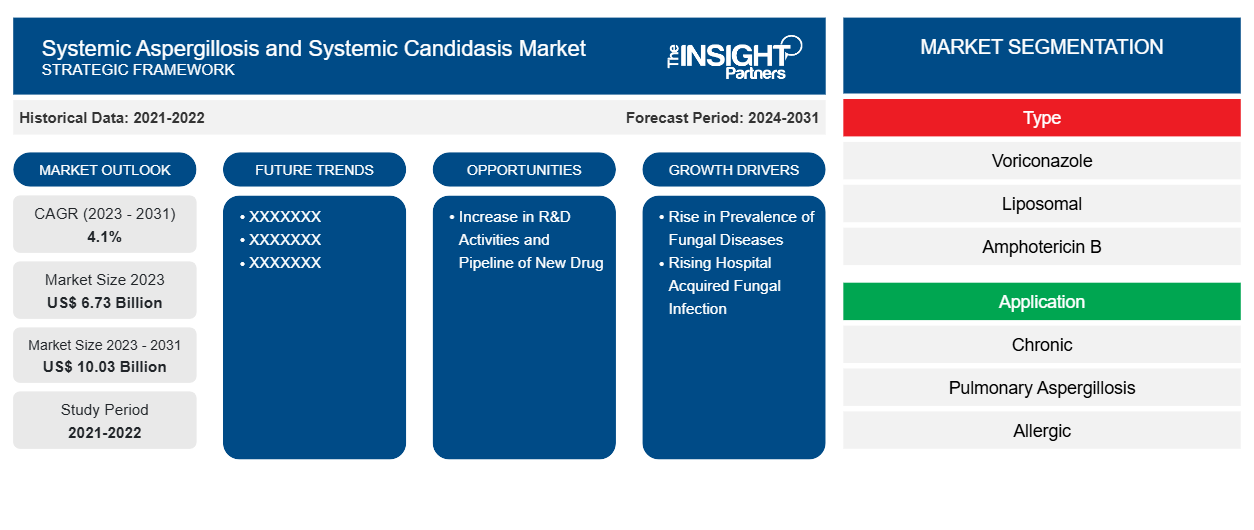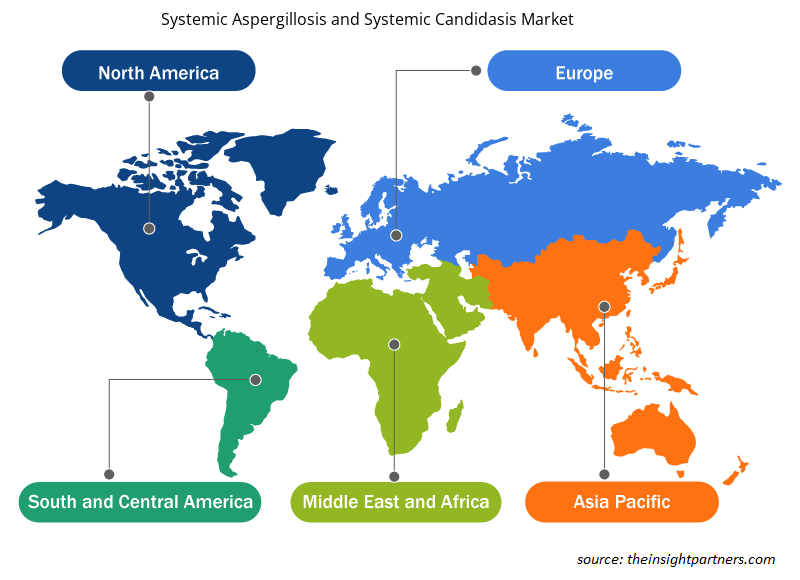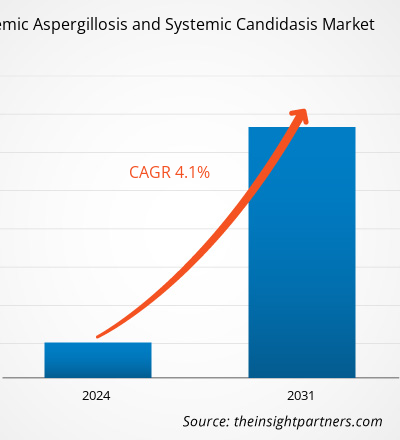Das Marktvolumen für systemische Aspergillose und systemische Candida wird voraussichtlich von 6,73 Milliarden US-Dollar im Jahr 2023 auf 10,03 Milliarden US-Dollar im Jahr 2031 anwachsen. Der Markt wird voraussichtlich zwischen 2023 und 2031 eine durchschnittliche jährliche Wachstumsrate von 4,1 % verzeichnen. Die Entwicklung neuartiger Therapien zur Behandlung von Pilzerkrankungen, die Zunahme der F&E-Aktivitäten zur Entwicklung von Medikamenten und die Zunahme von im Krankenhaus erworbenen Pilzerkrankungen werden voraussichtlich weiterhin die wichtigsten Markttrends für systemische Aspergillose und systemische Candidasis bleiben.Aspergillosis and Systemic Candidasis Market size is projected to reach US$ 10.03 billion by 2031 from US$ 6.73 billion in 2023. The market is expected to register a CAGR of 4.1% in 2023–2031. Development of novel therapies for treatment of fungal diseases, rise in R&D activities for development of drugs, and increasing hospital acquired fungal diseases are likely to remain key Systemic Aspergillosis and Systemic Candidasis Market trends.
Marktanalyse für systemische Aspergillose und systemische Candidasis
Aufgrund zunehmender Gesundheitsprobleme kommt es immer häufiger zu systemischer Aspergillose und systemischer Candidiasis. Da das Immunsystem aufgrund der HIV/AIDS-Pandemie, Tuberkulose, chronisch obstruktiver Lungenerkrankung (COPD), Asthma und der zunehmenden Zahl von Krebserkrankungen geschwächt wird, sind die Patienten anfälliger für Pilzerkrankungen. Daher treibt die zunehmende Verbreitung von Krankheiten, die das Immunsystem schwächen, das Wachstum des Marktes für systemische Aspergillose und systemische Candidiasis voran.
Marktübersicht für systemische Aspergillose und systemische Candidasis
Systemische Pilzinfektionen kommen häufig bei Patienten mit geschwächtem Immunsystem vor, darunter Patienten mit Immunsuppression und erworbenem Immunschwächesyndrom (AIDS). Zu den systemischen Symptomen zählen Apnoe, guajakpositiver Stuhl, Blähungen, Hyperglykämie, leukämoide Reaktion, Hypotonie und andere. Die Behandlung von systemischer Candidiasis und Aspergillose erfordert eine parenterale antimykotische Therapie und dieser Zustand ist mit einer hohen Sterblichkeitsrate verbunden. Darüber hinaus kann diese Infektion bei Langzeitüberlebenden zu dauerhaften neurologischen Entwicklungsdefiziten führen.immunosuppression and acquired immunodeficiency syndrome (AIDS) patients. Systemic signs consolidate apnea, guaiac-positive stools, abdominal distension, hyperglycemia, leukemoid reaction, hypotension, and others. The treatment of systemic candidiasis and aspergillos need parenteral therapyneurodevelopmental deficits in long-term survivors.
Passen Sie diesen Bericht Ihren Anforderungen an
Sie erhalten kostenlose Anpassungen an jedem Bericht, einschließlich Teilen dieses Berichts oder einer Analyse auf Länderebene, eines Excel-Datenpakets sowie tolle Angebote und Rabatte für Start-ups und Universitäten.
Markt für systemische Aspergillose und systemische Candidasis: Strategische EinblickeAspergillosis and Systemic Candidasis Market:

-
Holen Sie sich die wichtigsten Markttrends aus diesem Bericht.Dieses KOSTENLOSE Beispiel umfasst eine Datenanalyse von Markttrends bis hin zu Schätzungen und Prognosen.
Markttreiber und Chancen für systemische Aspergillose und systemische CandidasisAspergillosis and Systemic Candidasis Market Drivers and Opportunities
Steigende Zahl von im Krankenhaus erworbenen Pilzinfektionen begünstigt den Markt
Candida Auris ist ein Pilz, der eine ernsthafte globale Gesundheitsbedrohung darstellt. C. Auris verursacht bei Krankenhauspatienten in mehreren Ländern, darunter den Vereinigten Staaten, schwere Erkrankungen. Patienten mit C. auris haben Ausbrüche in Gesundheitseinrichtungen verursacht und können sich durch Kontakt mit betroffenen Patienten und kontaminierten Oberflächen oder Geräten verbreiten. Candida Auris kann lange Zeit mit C. Auris besiedelt bleiben, und C. Auris kann auf Oberflächen in Gesundheitsumgebungen bestehen bleiben. Dies kann zur Verbreitung von C. Auris zwischen Patienten in Gesundheitseinrichtungen führen. Laut einem CDC-Bericht aus dem Jahr 2021 wurden in den USA Fälle von C. Auris bei Patienten festgestellt, die sich kürzlich in Gesundheitseinrichtungen in Ägypten, Indien, Kenia, Kuwait, Pakistan, Südafrika, Südkorea, den Vereinigten Arabischen Emiraten und Venezuela aufgehalten hatten, wo auch Fälle dokumentiert wurden.Auris is a fungus that causes a serious global health threat. C. Auris causes severe illness in hospitalized patients in several countries, including the United States. Patients C. auris has caused outbreaks in healthcare facilities and can spread through contact with affected patients and contaminated surfaces or equipment. can remain colonized with C. Auris for a long time, and C. Auris can persist on surfaces in healthcare environments. This can result in the spread of C. Auris between patients in healthcare facilities. According to a CDC report of 2021, U.S. cases of C. Auris have been found in patients who had recent stays in healthcare facilities in Egypt, India, Kenya, Kuwait, Pakistan, South Africa, South Korea, the United Arab Emirates, and Venezuela, which also have documented cases.
Pipeline-Analyse – Eine Möglichkeit zur individuellen Behandlung von systemischer Aspergillose und systemischer CandidasisCustomisation of Systemic Aspergillosis and Systemic Candidasis
Die aktuelle Situation für systemische Aspergillose und systemische Candidiasis ist vielversprechend, mit mehreren Arzneimittelzulassungen, einer reichhaltigen Pipeline und vielen laufenden klinischen Studien. Die Pipelines für systemische Aspergillose und systemische Candidiasis befinden sich in verschiedenen Stadien der klinischen Entwicklung; große Pharmaunternehmen arbeiten daran, den Pipeline-Bereich und das zukünftige Wachstumspotenzial des Wettbewerbsbereichs systemische Aspergillose und systemische Candidiasis zu erweitern. So befindet sich beispielsweise Ibrexafungerp Citrate, ein Medikament zur Behandlung systemischer Candidiasis, derzeit in Phase III und wird von Scynexis entwickelt.aspergillosis and systemic candidasis is promising, with multiple drug approvals, a rich pipeline, and many ongoing clinical trials. Pipelines of systemic aspergillosis and systemic candidasis are in various stages of clinical development; major pharmaceutical companies are working to advance the pipeline space and future growth potential of the systemic aspergillosis and systemic candidasis competitive domain. For instance, Ibrexafungerp Citrate, a drug for treatment of systemic candidiasis, is currently in phase III and is developed by Scynexis.
Marktbericht zu systemischer Aspergillose und systemischer Candidasis – SegmentierungsanalyseAspergillosis and Systemic Candidasis Market Report Segmentation Analysis
Wichtige Segmente, die zur Ableitung der Marktanalyse für systemische Aspergillose und systemische Candidose beigetragen haben, sind Typ und Anwendung.Aspergillosis and Systemic Candidasis Market analysis are type and application.
- Basierend auf dem Typ ist der Markt für systemische Aspergillose und systemische Candidasis in Voriconazol, liposomales Amphotericin B, systemische orale Azole, topische Antimykotika und andere unterteilt. Das Segment der systemischen oralen Azole hatte 2023 den größten Marktanteil. Orale Azol-Medikamente wie Fluconazol, Ketoconazol und Itraconazol stellen einen großen Fortschritt in der systemischen Antimykotikatherapie dar. Von allen dreien hat Fluconazol das attraktivste pharmakologische (pharmakokinetische und pharmakodynamische) Profil, einschließlich der Fähigkeit, hohe Konzentrationen des Wirkstoffs in der Zerebrospinalflüssigkeit und im Urin zu produzieren.Aspergillosis and Systemic Candidasis Market is divided into voriconazole, liposomal amphotericin b, systemic oral azoles, topical antifungal agents and others. The systemic oral azoles segment held the largest market share in 2023. Oral azole drugs such as fluconazole, ketoconazole, and itraconazole have a major advancement in systemic antifungal therapy. Among all the three, fluconazole has the most attractive pharmacologic (pharmacokinetics and pharmacodynamic) profile, including the capacity to produce high concentrations of active drug in cerebrospinal fluid and urine.
- Nach Anwendung ist der Markt in chronische pulmonale Aspergillose (CPA), allergische bronchopulmonale Aspergillose (ABPA), gastrointestinale Candidose, Candidose des Urogenitaltrakts und andere unterteilt. Das Segment allergische bronchopulmonale Aspergillose (ABPA) hatte im Jahr 2023 den größten Marktanteil.
Systemische Aspergillose und systemische Candidasis Marktanteilsanalyse nach Geografie
Der geografische Umfang des Marktberichts zu systemischer Aspergillose und systemischer Candidasis ist hauptsächlich in fünf Regionen unterteilt: Nordamerika, Asien-Pazifik, Europa, Naher Osten und Afrika sowie Südamerika/Süd- und Mittelamerika.
Nordamerika dominiert den Markt für systemische Aspergillose und systemische Candidasis. Das Wachstum des regionalen Marktes wird auf die zunehmende Häufigkeit von Pilzinfektionen, die zunehmende Produktentwicklung und -einführung sowie die zunehmenden Initiativen zu Pilzinfektionen und deren Behandlung zurückgeführt. Darüber hinaus wird erwartet, dass die steigenden Gesundheitsausgaben für die Behandlung von Pilzinfektionen das Wachstum des Marktes im Prognosezeitraum zur Dominanz des nordamerikanischen Marktes für systemische Aspergillose und systemische Candidasis vorantreiben werden. Die USA gelten als der größte Markt für systemische Aspergillose und systemische Candidasis. Das Wachstum wird auf die zunehmende Häufigkeit von Pilzinfektionen zurückgeführt, die verschiedene Pharmaunternehmen weiter dazu ermutigen, in ihre F&E-Programme zu investieren und innovative Behandlungsmedikamente auf den Markt zu bringen. So gab Astellas Pharma Inc. im Januar 2020 bekannt, dass es von der FDA die Genehmigung für seinen ergänzenden Zulassungsantrag (sNDA) für MYCAMINE (Micafungin zur Injektion) erhalten hat. Der asiatisch-pazifische Raum wird in den kommenden Jahren voraussichtlich mit der höchsten durchschnittlichen jährlichen Wachstumsrate wachsen.Aspergillosis and Systemic Candidasis Market. The growth of the region's market is attributed to the increasing incidences of fungal infections and growing product development and launches, and rising initiatives about fungal infections and their treatments. In addition, the growing health expenditures for the treatment of fungal infections are expected to drive the growth of the market during the forecast period to the dominance of the North America Systemic Aspergillosis and Systemic Candidasis Market. US is estimated to be the largest market for systemic aspergillosis and systemic candidasis. The growth is attributed to the increasing incidences of fungal infections that further encourage various pharmaceutical companies to invest in their R&D programs and introduce innovative treatment medicines in the market. For instance, in January 2020, Astellas Pharma Inc. announced it had received approval from FDA for its supplemental New Drug Application (sNDA) for MYCAMINE (micafungin for injection). Asia Pacific is anticipated to grow with the highest CAGR in the coming years.
Regionale Einblicke in den Markt für systemische Aspergillose und systemische Candidasis
Die regionalen Trends und Faktoren, die den Markt für systemische Aspergillose und systemische Candidasis während des gesamten Prognosezeitraums beeinflussen, wurden von den Analysten von Insight Partners ausführlich erläutert. In diesem Abschnitt werden auch die Marktsegmente und die Geografie für systemische Aspergillose und systemische Candidasis in Nordamerika, Europa, im asiatisch-pazifischen Raum, im Nahen Osten und Afrika sowie in Süd- und Mittelamerika erörtert.

- Erhalten Sie regionale Daten zum Markt für systemische Aspergillose und systemische Candidasis
Umfang des Marktberichts über systemische Aspergillose und systemische Candidasis
| Berichtsattribut | Details |
|---|---|
| Marktgröße im Jahr 2023 | 6,73 Milliarden US-Dollar |
| Marktgröße bis 2031 | 10,03 Milliarden US-Dollar |
| Globale CAGR (2023 - 2031) | 4,1 % |
| Historische Daten | 2021-2022 |
| Prognosezeitraum | 2024–2031 |
| Abgedeckte Segmente |
Nach Typ
|
| Abgedeckte Regionen und Länder |
Nordamerika
|
| Marktführer und wichtige Unternehmensprofile |
|
Marktteilnehmerdichte: Der Einfluss auf die Geschäftsdynamik
Der Markt für systemische Aspergillose und systemische Candidasis wächst rasant, angetrieben von der steigenden Nachfrage der Endnutzer aufgrund von Faktoren wie sich entwickelnden Verbraucherpräferenzen, technologischen Fortschritten und einem größeren Bewusstsein für die Vorteile des Produkts. Mit steigender Nachfrage erweitern Unternehmen ihr Angebot, entwickeln Innovationen, um die Bedürfnisse der Verbraucher zu erfüllen, und nutzen neue Trends, was das Marktwachstum weiter ankurbelt.
Die Marktteilnehmerdichte bezieht sich auf die Verteilung von Firmen oder Unternehmen, die in einem bestimmten Markt oder einer bestimmten Branche tätig sind. Sie gibt an, wie viele Wettbewerber (Marktteilnehmer) in einem bestimmten Marktraum im Verhältnis zu seiner Größe oder seinem gesamten Marktwert präsent sind.
Die wichtigsten Unternehmen auf dem Markt für systemische Aspergillose und systemische Candidasis sind:
- Novartis AG
- Sanofi-Aventis
- Pfizer, Inc
- Merck und Co., Inc.
- Enzon Pharmaceuticals, Inc
- Bayer AG
Haftungsausschluss : Die oben aufgeführten Unternehmen sind nicht in einer bestimmten Reihenfolge aufgeführt.

- Erhalten Sie einen Überblick über die wichtigsten Akteure auf dem Markt für systemische Aspergillose und systemische Candidasis
Marktnachrichten und aktuelle Entwicklungen zu systemischer Aspergillose und systemischer Candidasis
Der Markt für systemische Aspergillose und systemische Candidasis wird durch die Erhebung qualitativer und quantitativer Daten nach Primär- und Sekundärforschung bewertet, die wichtige Unternehmensveröffentlichungen, Verbandsdaten und Datenbanken umfasst. Im Folgenden finden Sie eine Liste der Entwicklungen auf dem Markt für systemische Aspergillose und systemische Candidasis sowie Strategien:
- Pfizer hat Amplyx Pharmaceuticals, Inc. übernommen. Pfizer hat sich das Eigentum an Amplyx‘ Pipeline im Frühstadium gesichert, die potenzielle antivirale (MAU868) und antimykotische (APX2039) Therapien umfasst. (Quelle: Pfizer, Pressemitteilung, 2021)
- Basilea Pharmaceutica Ltd hat einen Kaufvertrag mit Amplyx Pharmaceuticals, Inc., einem Tochterunternehmen von Pfizer Inc., abgeschlossen und die Rechte an Fosmanogepix erworben, einem Breitband-Antimykotikumkandidaten in der klinischen Phase. Darüber hinaus hat Basilea die Rechte an einem präklinischen Antimykotikum erworben. (Quelle: Biospace, Pressemitteilung, 2023)
Marktbericht zu systemischer Aspergillose und systemischer Candidasis – Umfang und Ergebnisse
Der Bericht „Marktgröße und Prognose für systemische Aspergillose und systemische Candidasis (2021–2031)“ bietet eine detaillierte Analyse des Marktes, die die folgenden Bereiche abdeckt:
- Marktgröße und Prognose auf globaler, regionaler und Länderebene für alle wichtigen Marktsegmente, die im Rahmen des Projekts abgedeckt sind
- Marktdynamik wie Treiber, Beschränkungen und wichtige Chancen
- Wichtige Zukunftstrends
- Detaillierte PEST/Porters Five Forces- und SWOT-Analyse
- Globale und regionale Marktanalyse mit wichtigen Markttrends, wichtigen Akteuren, Vorschriften und aktuellen Marktentwicklungen
- Branchenlandschaft und Wettbewerbsanalyse, einschließlich Marktkonzentration, Heatmap-Analyse, prominenten Akteuren und aktuellen Entwicklungen
- Detaillierte Firmenprofile
- Historische Analyse (2 Jahre), Basisjahr, Prognose (7 Jahre) mit CAGR
- PEST- und SWOT-Analyse
- Marktgröße Wert/Volumen – Global, Regional, Land
- Branchen- und Wettbewerbslandschaft
- Excel-Datensatz
Aktuelle Berichte
Erfahrungsberichte
Grund zum Kauf
- Fundierte Entscheidungsfindung
- Marktdynamik verstehen
- Wettbewerbsanalyse
- Kundeneinblicke
- Marktprognosen
- Risikominimierung
- Strategische Planung
- Investitionsbegründung
- Identifizierung neuer Märkte
- Verbesserung von Marketingstrategien
- Steigerung der Betriebseffizienz
- Anpassung an regulatorische Trends






















 Kostenlose Probe anfordern für - Markt für systemische Aspergillose und systemische Candidasis
Kostenlose Probe anfordern für - Markt für systemische Aspergillose und systemische Candidasis